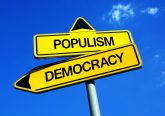In many of the standard narratives that political theory tells about its history and origins, Plato’s Republic stands out as a kind of foundation text of the discipline itself. As Plato’s most celebrated work of political theory, it is usually the first text taught in introductory surveys of the history of political thought. It is safe to say almost all political theorists – if not most political scientists – have had to study it over the course of their education and training.
Yet despite its canonical status and familiarity, the Republic is not always a straightforward text. Plato was, on top of being a philosopher, a master prose stylist who paid great attention to the literary construction of his dialogues. Nowhere in the Republic is this tension more pronounced, and the effect more jarring, than in its famously enigmatic conclusion, the Myth of Er.
The Myth of Er is a myth about the afterlife, and it describes in great detail the journeys that await souls there. It is also one of the great longstanding puzzles in the interpretation of the Republic: there is no scholarly consensus as to why Plato chose to the end his most important work of political theory in this strange way. In her seminal study of the work, the philosopher Julia Annas infamously called it a “lame and messy ending” to a “powerful and otherwise impressively unified book.” (She has since withdrawn these remarks, but the reasons she gave for her verdict continue to resonate with Plato’s frustrated readers.)
I have been thinking about the Myth of Er for many years, and I have come to the conclusion that the myth is most intelligible when it is read together with two iconic narratives that appear earlier in the text. These are the so-called Myth of Metals and the famous Allegory of the Cave, with which the Myth of Er shares a striking literary feature. Common to the way Plato frames all three of these stories is a recurring plot, in which a protagonist – or protagonists – is delivered from an underground slumber to wake up into a new reality above ground.
As it happens, both the Myth of Metals and the Allegory of the Cave appear at crucial junctures in the educational curriculum at the centre of the Republic: the former when the citizens have been sorted after a preliminary education in music and gymnastics, the latter when the potential guardians of Plato’s ideal city have undergone a more sophisticated training in dialectic. In both narratives, the motifs of slumber and waking are a metaphor for the transformative effect that education can have on the natures of its subjects.
The reappearance of this plot in the Myth of Er, I believe, helps us see that it is also about these same themes. The Myth of Er, in other words, builds on the ideas developed in the Myth of Metals and the Allegory of the Cave to give an account of how the nature of an individual can be a direct product of one’s education. Crucially, the myth suggests that the way we go about defining the very concept of nature has to be revised to reflect this dynamic process.
How does this reading change our understanding of the Republic? For a start, it helps us to make better sense of the pages that have the final word of the book, and in turn, to gain a better appreciation for its overall coherence.
Readers of the Republic often have a difficult time with the central analogy that structures the work – an analogy between the city and the soul – because they often feel pressured to choose which of the two embodiments of justice the book is really about. Justice writ large and small, in the city and in the individual soul, can often seem like two parallel manifestations that do not quite converge. But to ask, as the Myth of Er does, whether a philosophical education can leave a lasting effect on the nature of its subjects is to raise the question of whether the just city can in fact help make the soul more just.
Moreover, the reading also suggests a somewhat different portrait of Plato than the one often invoked in extant interpretations of the Myth of Er. Scholars have sometimes tried to account for the strangeness of the myth by presuming a certain, often elitist, distance between what Plato wrote and what he actually meant – by insisting the myth contained a hidden message for his true, philosophical audience, or conversely, by dismissing the myth as a crude form of rhetoric reserved for the unphilosophical masses.
But when we commit to taking the details of the Myth of Er seriously and at face value, it also allows us to picture a Plato who assumed a more earnest stance toward his readers, and who was not so quick to draw a natural distinction between philosophers and non-philosophers. For the author of the Myth of Er, philosophers were not born, but made. And what sets apart a philosophical nature from an unphilosophical one was not a fact of life, but an open question.
This post is based on the author’s recently published article, “Plato’s Myth of Er and the Reconfiguration of Nature,”forthcoming in the American Political Science Review.






